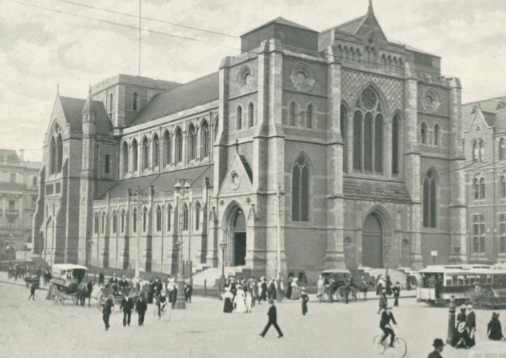The most iconic cathedral in Melbourne, Australia is St. Paul’s Cathedral, located in the central CBD district near Flinders Street Station..
St Paul’s Cathedral is an Anglican church. It serves as the diocese of Melbourne’s cathedral church. It is also the residence of the Archbishop of Melbourne, who is also the metropolitan archbishop of Victoria.
The cathedral was built in 1891, by English Gothic Revival architect William Butterfield. This is with the exception of the spires, which were constructed between 1926 and 1932 using a separate design. It is a significant architectural landmark in Melbourne.
St Paul’s Cathedral is located in a top location, at the centre of Melbourne, on the eastern corner of Swanston Street and Flinders Street. It is located opposite Flinders Street Station, which was the hub of the 19th- century Melbourne.
History of St Paul’s Cathedral
On the spot where Melbourne’s first public Christian service was held in 1835, St. Paul’s Cathedral now stands. The area was then used as a corn market and was a government reserve located far to the west of the town centre. The property was given to the Anglican Church in 1848 when it was close to the first Princes Bridge across the Yarra. In 1852, the Bluestone Church of St. Paul the Apostle was dedicated.
Colonial artist Samuel Thomas Gill designed St. Paul’s Church in 1854. A lithograph titled ‘St. Paul’s Church Melbourne 1854’ is part of his Sketch in Victoria album and was digitised by the National Library of Australia in 2021.
The diocese opted to replace the 1839 St. James Old Cathedral with a large cathedral on the site about 30 years later. This was as a result of the enormous growth of the city and Swanston Street being a prominent route. The new cathedral was created by the English architect William Butterfield. He was renowned for his unique take on the Gothic Revival.
Construction of St. Paul’s Cathedral
In the presence of the Rt Revd Charles Perry, Bishop of Melbourne, the foundation stone was placed in 1880. It was placed by the Governor of Victoria, John, Earl of Hopetoun (later Marquess of Linlithgow). The cathedral was dedicated by the Rt Revd Field Flowers Goe, Bishop of Melbourne, on January 22, 1891. However at this stage it was without the spires.
Butterfield resigned in 1884 as a result of disagreements he had with Melbourne’s church officials during the construction project. After that, the task was given to a local architect, Joseph Reed. He finished the structure largely in accordance with Butterfield’s plans and also created the chapter house that was linked to it in 1889. Instead of facing east, as is customary, the cathedral is aligned with the central city grid, in order to suit the block.
The pipe organ was specially made by the English builder T.C. Lewis. He was one of the most prominent organ builders of the 19th century.
Constructing the spires
Without the spires, the church appeared as a relatively monolithic, horizontal bulk for almost 40 years. The spires’ construction started in 1926 under a revised design by Sydney architect John Barr. The project used different stone from the Sydney region and a more conventional Gothic Revival shape. Additionally, it was much taller than Butterfield’s first concept.
A service of thanksgiving was held on April 30, 1933, to celebrate the completion of the spires. They had achieved their maximum height in 1932. As soon as the Moorhouse Spire, the church’s central spire, reached its full height of 312 feet (95 meters), St. Paul’s overtook all other buildings in central Melbourne. It dominated the city’s skyline when viewed from the south.
The cathedral’s exterior underwent extensive renovation in the 1960s. Plus the organ was restored in 1989 with the aid of a significant National Trust appeal. In 2009, considerable repairs to the spires and other significant restoration projects were completed. This included the installation of a coloured glass lantern in the Moorhouse Tower. As well as coloured glass doors and a glass-walled airlock at the Great West door.
St. Paul’s lost its claim to height as multi-story buildings grew in central Melbourne in the latter 20th century. However, thanks to the retail heart height limit of 40 meters, it has continued to dominate the surrounding region. The 16-story Gas & Fuel buildings were rather dominant for approximately 30 years. They were constructed along Flinders Street to the east in 1967. However, they were destroyed in 1997 to make room for Federation Square.
Restoration of St Paul’s Cathedral
By the 1990s, worries regarding the cathedral’s structural stability, notably its spires, were raised. This was as a result of the constant traffic vibration in central Melbourne. For the purpose of restoring the spires and enhancing the building’s interior, A$18 million was gathered. This was collected through a public appeal organised by the then-Dean of Melbourne, David Richardson.
The year 2009 saw the conclusion of the seven-year restoration project. It had been was overseen by Falkinger Andronas Architects and Heritage Consultants (now Andronas Conservation Architecture). The Cathedral Stone’s repair efforts were recognised with many awards. These included the Australian Institute of Architects and the Victorian Chapter Heritage Architecture Award 2009. In addition, it won the Lachlan Macquarie National Award for Heritage Architecture 2009.
In addition, new dalle de verre glass was made by Janusz and Magda Kuszbicki for the west doors. Also, the “Eighth Day” lantern in the Moorhouse Tower was created. As well as stone heads of the former dean David Richardson and the philanthropist Dame Elisabeth Murdoch. These were created by Melbourne sculptor Smiley Williams and carved by stonemason Daryl Gilbert.
The cathedral, the only Australian Anglican cathedral to do so, “maintains the English tradition” of a daily choral Evensong. This is in addition to Sunday and weekday Eucharists.
Pipe organ at St Pauls
The pipe organ of the cathedral was constructed by T. C. Lewis & Co. in Brixton, England. Its manufacture, shipment, and installation cost almost 6,000 pounds. It was used at the cathedral’s opening service in 1891. Since then, a number of alterations and upkeep tasks have been done. These led to a A$726,000 restoration that was finished in 1990 with the aid of a National Trust appeal. The organ is located in the south transept of the cathedral behind freshly stencilled façade pipes. It has four manuals, 53 stops, and pedals with electro-pneumatic action.
Belfry at St Pauls
Twelve bells in St. Paul’s ring are set for change ringing in the key of C. While an additional bell allows for the ringing of various subsets of the complete number while maintaining a diatonic scale. Mears & Stain bank of the Whitechapel Bell Foundry crafted all 13 bells in 1889. The set as a whole was shipped to Taylor’s Bell Foundry in 1963 for tuning. This tuning reduced the tenor’s weight from 31cwt to 29cwt.
The bells were a gift from Thomas Dyer Edwardes, and they were dedicated and rung for the first time on November 15, 1889. They were rung to mark Sir Henry Loch’s retirement as the Governor of Victoria (later Baron Loch). The Australian and New Zealand Association of Bellringers is a member organisation of the St. Paul’s Cathedral Society of Bellringers, which was established in 1896.
If you would like to learn more about the history of Melbourne and visit the city’s iconic attractions, join us on a Go West Tour.
Written by: Jessica Senden – Marketing Intern @gowest.com.au




